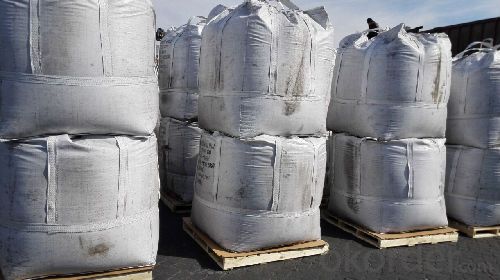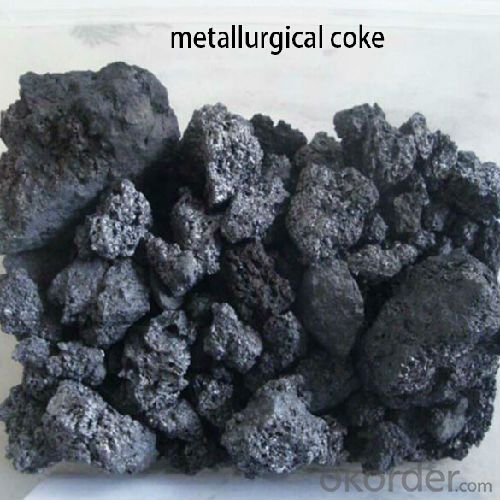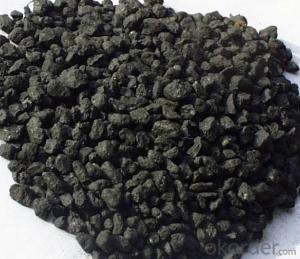CPC Low Sulfur Petroleum Coke FC 98.5% Cheap Price
- Loading Port:
- Tianjin
- Payment Terms:
- TT or LC
- Min Order Qty:
- 20 m.t.
- Supply Capability:
- 3000 m.t./month
OKorder Service Pledge
OKorder Financial Service
You Might Also Like
Packaging & Delivery
| Packaging Detail: | 50kg/bag 100kg/bag 1000kg/bag Or according with client need |
| Delivery Detail: | 2 weeks |
Specifications
CPC Low Sulfur Petroleum Coke FC 98.5% Cheap Price
Petroleum coke products can be divided into needle coke, sponge coke, projectile coke and coke breeze four kinds.
Calcined Petroleum Coke
F.C.: 98.5%MIN
ASH: 0.8% MAX
V.M.: 0.7%MAX
S:0.5%MAX
Moisture: 0.5%MAX
Structure
CPC Low Sulfur Petroleum Coke FC 98.5% Cheap Price
Shape: granule
Dimensions: 0-1mm, 1-5mm, 1-6mm, 2-8mm, etc
Product Type: Carbon Additive
C Content (%): 98-99.5% MIN
Working Temperature: -
S Content (%): 0.5%-0.7%MAX
Ash Content (%): 0.7%MAX
Volatile:0.8%MAX
Moisture: 0.5% MAX
ADVANTAGE: low ash & sulfur
COLOR: Black
Feature
CPC Low Sulfur Petroleum Coke FC 98.5% Cheap Price
Physics and chemistry performance :
Unit | Index | |||||
No.1 | No.2 | No.3 | ||||
Density | g/cm3 | 2.04 | 2.00 | 2.00 | ||
sulphur content | %≤ | 0.5 | 1.0 | 2.5 | ||
volatility | %≤ | 0.5 | 0.5 | 0.5 | ||
ash content | %≤ | 0.5 | 0.5 | 0.5 | ||
moisture | %≤ | 0.3 | 0.5 | 0.5 | ||
charcoal | %≤ | 98.5 | 98.0 | 98.0 | ||
Image
CPC Low Sulfur Petroleum Coke FC 98.5% Cheap Price


FAQ:
CPC Low Sulfur Petroleum Coke FC 98.5% Cheap Price
How to classify calcined petroleum coke?
1) According to difference of sulfur content, can be divided into high sulfur coke (sulfur content more than 4%), sulphur in coke sulfur content (2% 4%) and low sulfur coke (sulfur content below 2%).
2) Petroleum coke products can be divided into needle coke, sponge coke, projectile coke and coke breeze four kinds:
3) Needle coke, has obvious needle-like structure and fiber texture, mainly used for steel-making in high power and ultra-high power graphite electrode. As a result of needle coke in sulfur content, ash content, volatile matter and true density and so on have strict quality requirements, so the production process of needle coke and raw materials have special requirements.
4) The sponge coke, high chemical reactivity, low content of impurities, mainly used in the aluminum industry and carbon industry.
5) Focal or spherical coke: the projectile shape is round, diameter 0.6-30 mm, usually from the production of high sulphur, high asphaltic residual oil, can only be used as industrial fuel power generation, cement etc.
6) Coke breeze: fluidized coking process, the fine particles (0.1- 0.4 mm) in diameter, high volatile, high expansion coefficient, cannot be directly used for electrode preparation and carbon industry.
Advantage:
CPC Low Sulfur Petroleum Coke FC 98.5% Cheap Price
1. High quality and competitive price.
2. Timely delivery.
3. If any item you like. Please contact us.
Your sincere inquiries are typically answered within 24 hours.
- Q:How does carbon impact the prevalence of floods?
- Carbon does not directly impact the prevalence of floods, but it does play a significant role in influencing climate change, which in turn can affect the occurrence and severity of floods. Carbon dioxide (CO2) is a greenhouse gas that is primarily responsible for trapping heat in the Earth's atmosphere, leading to a phenomenon known as global warming. This rise in global temperatures has several consequences, one of which is an increase in the frequency and intensity of extreme weather events, including floods. As the planet warms, the atmosphere is able to hold more moisture, resulting in an increased likelihood of heavy precipitation events. This can lead to more intense rainfall, causing rivers and other water bodies to overflow their banks and resulting in flooding. Additionally, warmer temperatures can also cause glaciers and ice caps to melt, contributing to rising sea levels, which can exacerbate the impacts of flood events, particularly in coastal regions. Furthermore, carbon emissions from human activities such as burning fossil fuels and deforestation are the primary drivers of climate change. By reducing our carbon footprint and transitioning to cleaner sources of energy, we can help mitigate the impacts of climate change and potentially reduce the prevalence of floods in the long term. It is important to note that while carbon emissions are a significant factor in climate change, they are not the sole cause of floods. Other natural factors such as rainfall patterns, topography, and land use also play important roles in determining flood risks.
- Q:What is carbon black dye?
- Carbon black dye is a pigment derived from the incomplete combustion of hydrocarbons, commonly used in various industries, including the production of inks, plastics, rubber, and coatings.
- Q:What is carbon black ink?
- Carbon black ink is a type of ink that is made by dispersing carbon black pigment in a liquid medium. It is commonly used in printing and writing applications due to its deep black color and high opacity.
- Q:What is the density of carbon steel and alloy steel?
- Manganese steel 7.8115CrA 7.74 steel20Cr, 30Cr, 40Cr steel, 7.8238CrA 7.80 steelChromium vanadium, chromium nickel, chromium nickel molybdenum, chromium, manganese, silicon, manganese, nickel chromium manganese silicon silicon steel 7.85Chromium nickel tungsten steel 7.80
- Q:Is carbon a conductor?
- It depends on what kind of material, the cartridge is the conductor, and the coal is not the conductor
- Q:How is carbon used in the steel industry?
- The steel industry heavily relies on carbon as it plays a crucial role in the production and enhancement of steel. Carbon is added to iron in the fundamental process that transforms it into steel, resulting in the desired properties of hardness, strength, and durability. In steelmaking, carbon is primarily used as an alloying element to improve the mechanical properties of steel. The carbon content in steel can vary depending on the desired grade and application, ranging from 0.1% to 2%. Low carbon steel, with a carbon content below 0.3%, is commonly used for applications that require good formability and weldability. On the other hand, high carbon steel, with a carbon content above 0.6%, is used for applications that demand high strength and hardness. Carbon also plays a crucial role in the heat treatment process of steel. Through carburizing, steel undergoes a heating process with carbon-rich gases or solids to increase the carbon content at the surface. This results in a hardened surface layer with improved wear resistance, while maintaining a tough and ductile core. Additionally, carbon is essential in the use of electric arc furnaces (EAFs) in steelmaking. EAFs utilize electricity to melt scrap steel and other raw materials. Carbon is introduced during this process to reduce the oxides present in the raw materials, allowing for efficient steel production. In conclusion, carbon is widely utilized in the steel industry to achieve the desired properties of steel, enhance its mechanical properties through heat treatment, and enable efficient steel production. This versatile element enables steel to be used in a wide range of applications across various industries.
- Q:What are the impacts of carbon emissions on the stability of mountains?
- Carbon emissions can have various impacts on the stability of mountains. One significant effect is the acceleration of glacial melting, leading to increased water runoff and the potential for more frequent and severe landslides. Additionally, carbon dioxide contributes to the acidification of rainwater, which can corrode rocks and weaken the stability of mountain slopes. Climate change, driven by carbon emissions, also leads to alterations in precipitation patterns, temperature, and weather events, increasing the risk of erosion, rockfalls, and avalanches. Overall, carbon emissions have a detrimental influence on the stability of mountains, posing risks to both human populations and ecosystems.
- Q:What are the effects of carbon emissions on agriculture?
- Agriculture is significantly harmed by carbon emissions, with various negative effects. Firstly, the presence of higher levels of carbon dioxide (CO2) in the atmosphere contributes to global warming, resulting in changes in rainfall patterns and more frequent occurrences of extreme weather events like droughts, floods, and heatwaves. These weather conditions disrupt agricultural production by reducing crop yields, damaging crops, and increasing the prevalence of pests and diseases. Higher temperatures also accelerate evaporation, which leads to soil moisture deficits and water scarcity. This has a detrimental impact on crop growth and productivity. Additionally, elevated CO2 levels can modify the nutritional composition of crops, reducing their quality and nutritional value. Research has demonstrated that increased CO2 concentrations can decrease the protein content in wheat and rice, potentially causing health issues for those who heavily rely on these staple crops. Moreover, carbon emissions contribute to the formation of ground-level ozone, a harmful air pollutant. Ozone damages plant cells, inhibits photosynthesis, and reduces crop yields. It particularly affects sensitive crops such as soybeans, wheat, and cotton. The consequences of carbon emissions on agriculture extend beyond crop production. Livestock farming is also affected, as rising temperatures and water scarcity make it more difficult to maintain adequate grazing lands and provide sufficient water and fodder for animals. Furthermore, changes in climate patterns can facilitate the spread of livestock diseases and pests, posing additional risks to the livestock industry. In conclusion, carbon emissions have far-reaching effects on agriculture, resulting in decreased crop yields, diminished nutritional value, challenges in livestock farming, and increased vulnerability to pests, diseases, and extreme weather events. It is crucial to address and mitigate carbon emissions to safeguard global food security and ensure the sustainability of agricultural systems.
- Q:What are the properties of activated carbon?
- Activated carbon, also known as activated charcoal, possesses several unique properties that make it highly versatile and useful in various applications. 1. Adsorption: One of the most significant properties of activated carbon is its high adsorptive capacity. It has a vast internal surface area due to its porous structure, which allows it to effectively adsorb molecules, ions, and impurities from gases, liquids, and solids. This adsorption capability makes it ideal for purification purposes, such as water and air filtration, as well as in the removal of toxins and pollutants from industrial processes. 2. Porosity: Activated carbon has a highly porous structure with a network of interconnected pores. This porosity provides a large surface area, enabling it to trap a significant amount of contaminants. The pores can be classified into three types: micropores (less than 2 nm), mesopores (2-50 nm), and macropores (greater than 50 nm), each contributing to its adsorption capacity. 3. Chemical Stability: Activated carbon exhibits excellent chemical stability, making it resistant to degradation and breakdown when exposed to various chemicals or environments. This property allows it to maintain its adsorption capacity over a long period and under harsh conditions, ensuring its efficiency and longevity in different applications. 4. Selectivity: Activated carbon can be tailored to exhibit selectivity towards specific substances by modifying its surface properties. Through various activation processes, such as physical or chemical treatments, the surface chemistry of activated carbon can be altered to enhance its affinity for certain molecules or contaminants, while reducing its affinity for others. This selectivity makes it an effective material for specific applications, such as removing specific pollutants or capturing desired compounds. 5. Regenerability: Another advantageous property of activated carbon is its regenerability. After reaching its adsorption capacity, it can be regenerated by heating or washing with appropriate solvents, allowing it to be reused multiple times before replacement. This regenerability not only reduces the operational costs but also contributes to its sustainability and eco-friendliness. 6. Low Density: Activated carbon has a relatively low density, making it lightweight and easy to handle. This property enables its use in various systems and devices without adding excessive weight or bulk. 7. Thermal Stability: Activated carbon possesses high thermal stability, allowing it to withstand high temperatures without significant degradation. This property makes it suitable for applications involving high-temperature processes, such as gas purification or catalytic reactions. Overall, the properties of activated carbon, including its adsorption capacity, porosity, chemical stability, selectivity, regenerability, low density, and thermal stability, make it a versatile material widely used in water and air purification, gas separation, chemical processing, pharmaceuticals, and many other industries.
- Q:But their chemical symbols are different, so they are different elements, different substances, but they feel the same thing... Tangled up ~!
- No one is the same. Lead is poisonous, and pencil lead is lead. The structure of carbon is the same as that of diamonds. Generally speaking, they are of structure, density and composition. No one is the same
1. Manufacturer Overview |
|
|---|---|
| Location | |
| Year Established | |
| Annual Output Value | |
| Main Markets | |
| Company Certifications | |
2. Manufacturer Certificates |
|
|---|---|
| a) Certification Name | |
| Range | |
| Reference | |
| Validity Period | |
3. Manufacturer Capability |
|
|---|---|
| a)Trade Capacity | |
| Nearest Port | |
| Export Percentage | |
| No.of Employees in Trade Department | |
| Language Spoken: | |
| b)Factory Information | |
| Factory Size: | |
| No. of Production Lines | |
| Contract Manufacturing | |
| Product Price Range | |
Send your message to us
CPC Low Sulfur Petroleum Coke FC 98.5% Cheap Price
- Loading Port:
- Tianjin
- Payment Terms:
- TT or LC
- Min Order Qty:
- 20 m.t.
- Supply Capability:
- 3000 m.t./month
OKorder Service Pledge
OKorder Financial Service
Similar products
New products
Hot products
Hot Searches
Related keywords






























